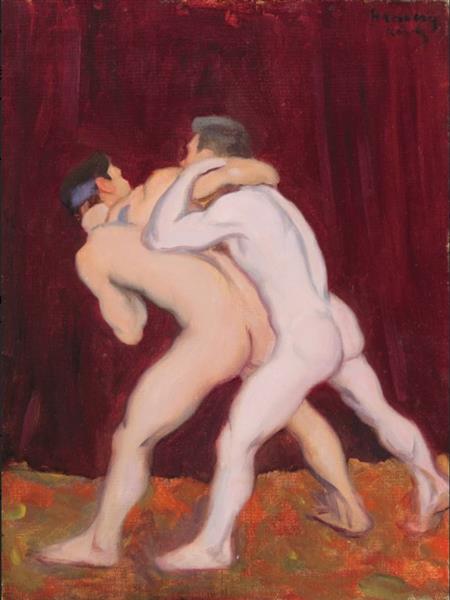Description
"Birkodok 1912" by Károly Ferenczy is a resonant manifestation of physical vigor and human grace on the canvas. This painting, that dates from 1912, is inscribed at a time of the Hungarian artist's career where his style reached full maturity, verifiable in his domain of light and composition.
In "Birkodok 1912", Ferenczy captures a moment of struggle between two athletic bodies, fusing the tension with the aesthetics in a captivating way. The bodies of the fighters, sculpted with impressive anatomical precision, are in an entanglement that reflects both exhaustion and a latent force. The painting is located in a figurative tradition, but what stands out is the way in which Ferenczy Orchestra color and light to infuse dynamism in the scene represented.
The space where the action takes place is essentially abstract, with a background that avoids any distraction of the main act. The land painted in terrible and ocher tones underlines the intimacy of the duel and provides a useful contrast to the meat and muscle game in the foreground. This use of the earthy color not only enhances the human figure, but also anchor the scene in a palpable reality, almost as if we could feel the dust raised by the movements of the fighters.
The artistic composition is governed by a remarkable balance. The bodies, although in confrontation, are represented with a respect for symmetry and balance, a testimony of Ferenczy's ability to harmonize physical conflict with a stable visual structure. The arms and legs of the fighters create an almost architectural framework, revealing the mastery of the painter in the representation of the perpetual movement within the permanence of the canvas.
Light in the work is particularly significant. Ferenczy manages subtle gradations of light and shadow to model muscle contours, giving three -dimensionality that encourages the figures. The light affects the sweaty backs and torsions of the torso, introducing a sensation of immediacy and reality. This technique not only illuminates physical forms but also imbues the scene of a specific emotional atmosphere a mixture of sporting stress, effort and nobility.
Ferenczy was a central figure in the movement of Hungarian modernism, and "Birkozok 1912" is an eloquent example of his ability to integrate impressionist and postimpressionist influences within his own pictorial language. His work, although rich in realistic details, transcends mere physical representation to venture into the depths of human experience against adversity and competition.
In the context of European art of the early twentieth century, this painting dialogues with the contemporary explorations of the human figure and the body in action, reminiscent to some extent of the work of Augusto Rodin in sculpture or Eugène Carrière in painting, although always maintaining its distinctive identity and an explicitly pictorial approach. Ferenczy's emphasis at the intersection between strength and beauty, and in the human condition as manifested in the body, somehow anticipates the explorations of future artists who would seek to document and understand the fragility and resilience of the human being.
"Birkodok 1912" not only stands out for its impeccable technique and its deep perception of human anatomy in action, but also for its ability to capture a moment of universal and timeless drama. It is a celebration of competition and art itself, a confirmation of the motto that even the most fierce clashes can be transformed into a visual ballet under the eyes of a master Like Károly Ferenczy.
KUADROS ©, a famous paint on your wall.
Hand-made oil painting reproductions, with the quality of professional artists and the distinctive seal of KUADROS ©.
Art reproduction service with satisfaction guarantee. If you are not completely satisfied with the replica of your painting, we refund your money 100%.

